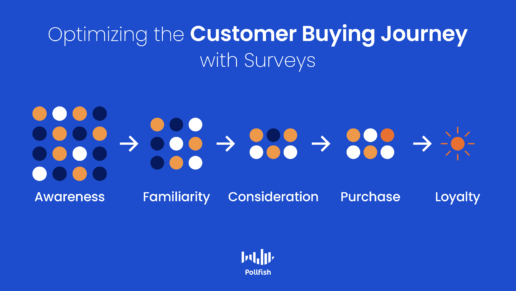How to Create a Customer Journey Survey for All of its Stages
How to Create a Customer Journey Survey for All of its Stages
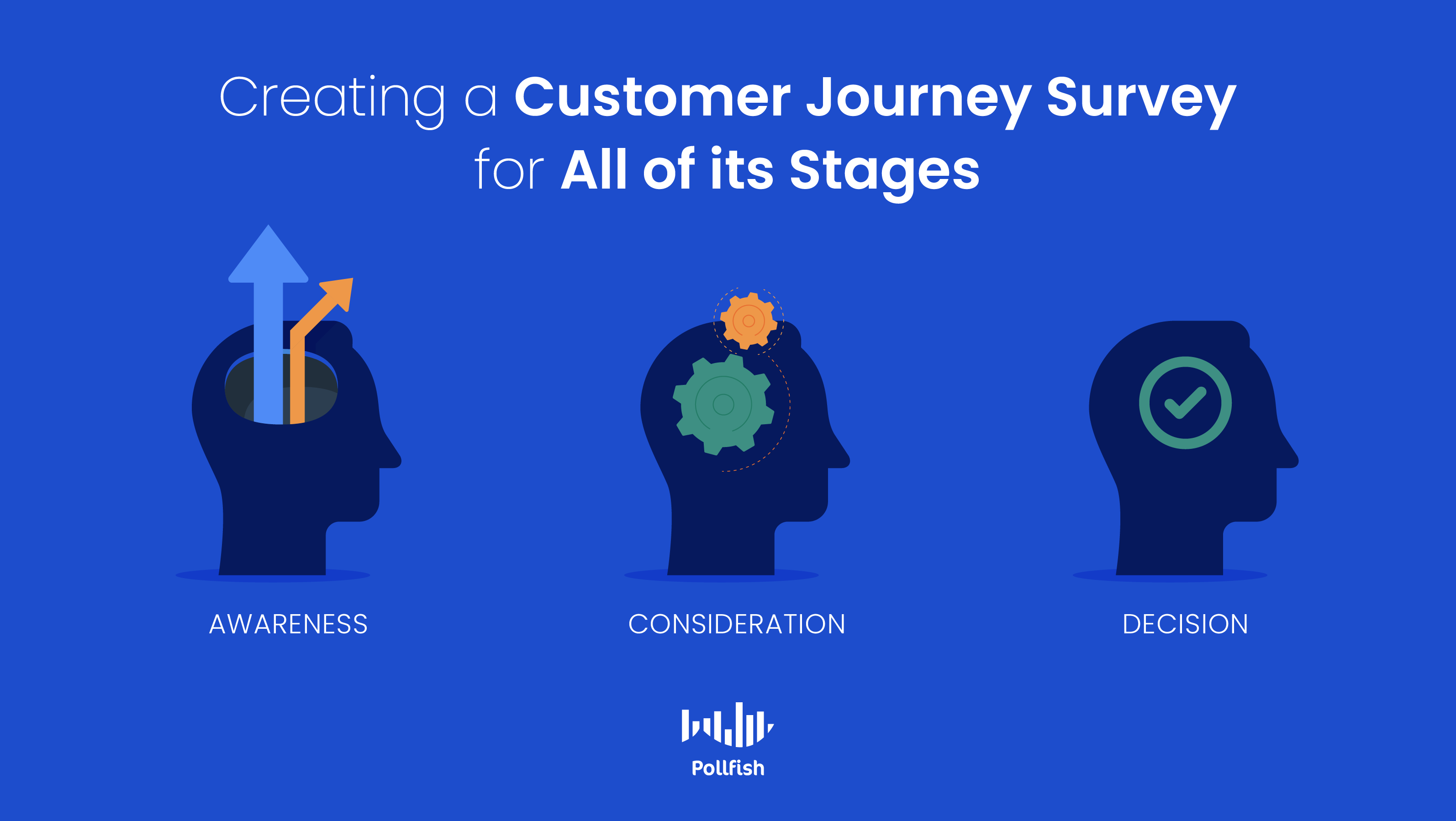
Brands ought to create a customer journey survey to observe how their consumers traverse throughout their buying journey.
After all, 76% of customers expect companies to understand their needs and expectations, and It is the customer-centric companies that reap more profits, typically yielding 60% higher profits than companies that aren’t.
Understanding customers’ needs and expectations largely involves understanding their customer buying journey to properly cater to them, as no customer journey is exactly equivalent.
Some customers may undergo long customer journeys before converting. Other customers may detour and head straight to the checkout, while others may leave mid-journey without making a purchase or converting whatsoever.
This article explains the customer journey survey, why it’s useful and important, how to create one and the questions to use for all of its key stages.
Understanding the Customer Journey Survey
The customer journey survey is a kind of survey that examines consumers in relation to their customer buying journey, as its name suggests. It probes customers on the common things they experience and feel throughout their journey, including specific parts of it.
The customer buying journey is a path of all customers’ digital (and sometimes physical) visitations, behaviors and actions before they make a purchase.
This journey is a kind of process in which customers become aware of, examine and evaluate and make the decision to purchase a new product or service. In the digital space, these journeys do not always conclude with a purchase, as sometimes, they are cut short when a consumer decides to purchase elsewhere or not all.
The customer journey survey can be holistic, covering all parts of a customer journey that businesses either perceive or discover by previously surveying their customers or getting feedback via a voice of customer (VoC) program. This survey can also focus on a key aspect of the buying journey, such as one of its three main stages.
The three main stages of a customer journey are the awareness stage, the consideration stage and the decision stage. Businesses ought to deploy different tactics in their content marketing strategy, along with their ecommerce strategy so that customers stay engaged in each of these stages and are prompted to the next one, until they finally make a purchase.
The Importance of the Customer Journey Survey
This kind of survey is important in several ways. Firstly, it helps form the journey itself at a high level, serving as a tactic for customer journey mapping. This practice entails establishing a visual depiction of customer processes, needs & perceptions during their interactions and relationship with a business.
Customer journey mapping is as significant for small and medium-sized businesses as it is for larger enterprises.
Essentially, the customer journey survey allows businesses to map out the customer journey itself. Rather than forming one through assumptions or online templates, this kind of survey shows businesses exactly what customers are doing, thinking and feeling in their journey.
As such, the insights from this survey enable businesses to form their own customer journey maps which they can use for future marketing campaigns or for their strategic planning process.
By understanding the journey of your customers when they engage with your company, this survey type allows businesses to understand the steps customers take – which includes the steps that are easily accessible for brands and the ones that aren’t.
These steps are important for a number of reasons; they include triggers that incite customers to take some kind of action, whether that is clicking through an ad to its landing page, going further into their journey or finally making a purchase.
For example, these steps can include online review, in which 95% of customers read online reviews before visiting a business. 54% of shoppers comparison shop when they browse online, another crucial step in their final purchasing decision.
As such, it is important for businesses to understand the steps of a customer journey, as they shine a light on key customer insights, allowing brands to not simply map out their customer buying journeys, but optimize them.
In addition, being able to map out and improve the customer journey involves taking the proper steps towards making an impact. In this case, the customer journey survey is effective for configuring and optimizing budgets. This is because it shows businesses how customers are reacting to certain messaging, images, offers and other aspects of their customer experience.
In doing so, the customer journey survey is critical to improving your customer experience (CX), as it dictates how customers feel about a business and plays a major role in customers’ purchasing decisions. This survey helps improve CX, as it allows researchers to diagnose existing issues in their journeys, in turn, allowing businesses to tend to those issues, fix them and innovate more on their customer journey, products and CX as a whole.
Creating a Customer Journey Survey
Creating this kind of survey requires taking several key considerations.
First off, if it is your first customer journey survey, you may need to first form a high-level customer journey map that lays out your expected customer journeys. In order to map out this preliminary customer journey, use an analytics source, such as Google Analytics, or a specialized one, such as one that offers session replay.
These tools allow you to access key analytics on your digital traffic, allowing you to see how a customer made their way to a webpage — whether they clicked on an ad or arrived organically — the duration of their visit, how they traversed a site, how they engaged and more.
These insights will help you design your customer journey map and allow you to categorize your journey into the three aforementioned stages of awareness, consideration and decision. It won’t give you much insight into the kinds of customer personas and segments that are taking these journeys. That’s where the customer journey survey becomes incredibly useful.
Not only does this survey let you examine customers' stages and mindsets throughout their journeys, but to identify the kinds of journeys typical among your customer segments and personas.
After you parse through your analytics and other digital traffic tools, refer to your customer segments and their habits. If you do not have access to this, you should conduct market segmentation, another practice made possible thanks to consumer surveys.
Once you have studied your customer segments, consider the segments and personas whose journeys you intend to survey. It is possible that you may need to survey them all to get a clear picture of your customer journeys across personas.
Either way, begin your customer journey survey by organizing each sub-campaign by each persona type. You can also group sub-campaign based on journeys in a certain marketing campaign, such as a particular offer or landing page. The most important thing is to pin down the purpose of your survey campaign so that you have a central point of study.
Next, consider which stages you need to survey; having observed your analytics helps you determine this. If you need to study all stages, consider creating surveys in chronological order. Come up with some key inquiries you need to be answered.
Then, choose from the question examples to use in each step of the journey from the examples in the following sections.
Survey Questions for Awareness
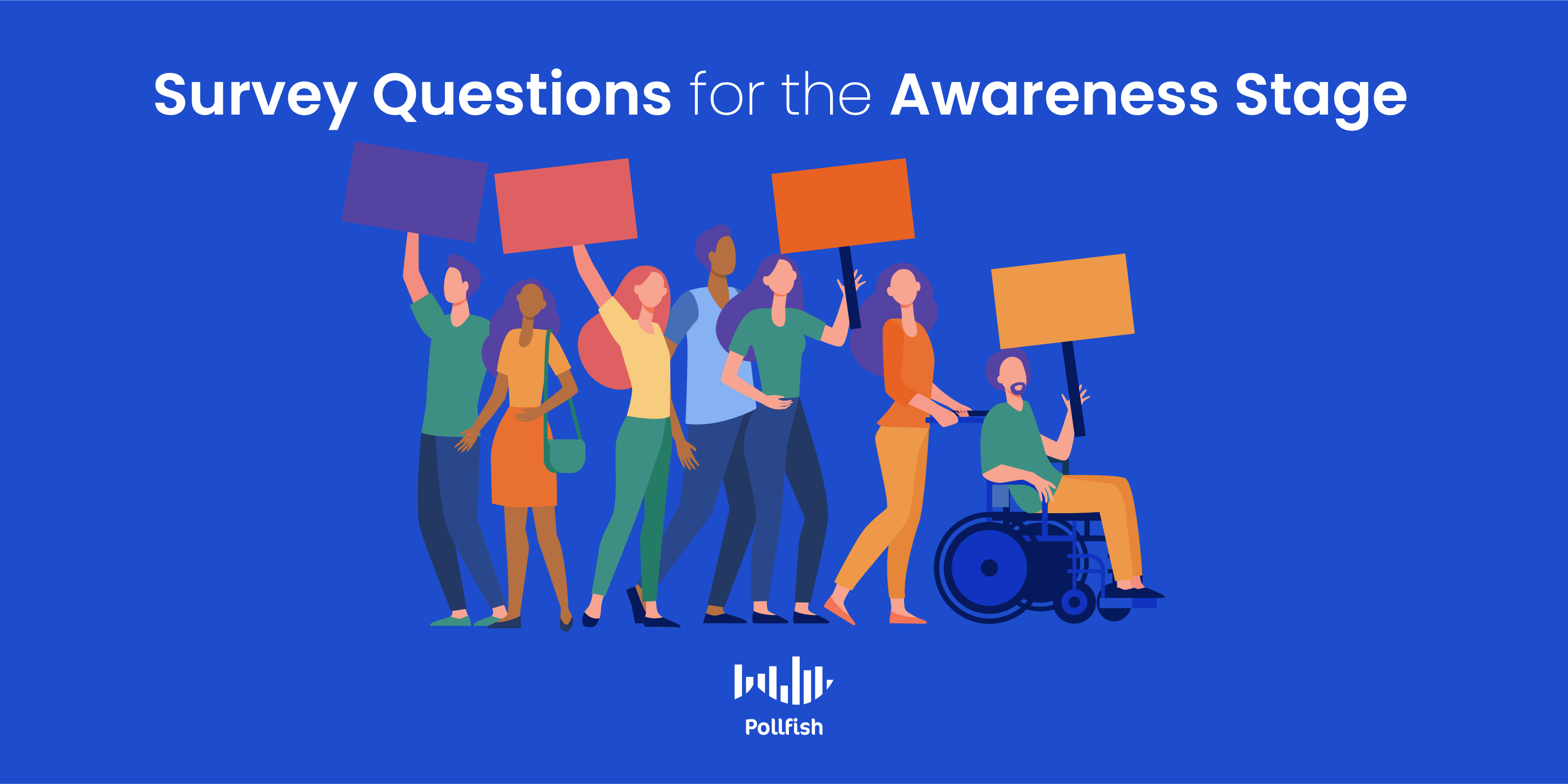
- What is the biggest problem you have with [something pertaining to your niche/products]?
- Answer type: Multiple-choice, multiple-selection, with an open-ended field option
- What bothers you the most about [completing an action, buying a product in your niche, etc.]
- Answer type: Multiple-choice, with an open-ended field option
- How do you usually go about fixing this problem?
- Answer type: Multiple-choice, with an open-ended field option
- What have you considered to fix/ tackle this problem?
- Answer type: Multiple-choice, with an open-ended field option
- Have you considered using [your brand] for this problem?
- Answer type: Yes or no, followed by a follow-up question on whether they’ve tried competitors’ products/services and another question on what they like/ dislike about them.
- Apply skip advanced logic to route your respondents to follow-up questions.
Survey Questions for Consideration
- What are your biggest concerns about [the problem]?
- Answer type: Multiple-choice, multiple-selection, with an open-ended field option
- What is the easiest way for you to solve this issue?
- Answer type: Multiple-choice, with an open-ended field option
- What would make you choose to try [your brand] if you haven’t already?
- Answer type: Multiple-choice, multiple-selection, with an open-ended field option
- What do you think of this selection? [Mid-funnel journey question for users of product pages, site menus, etc]
- Answer type: Multiple-choice, multiple-selection
- How would you rate our services based on the following? [Use image of an ad with a list of strengths relating to buying from your brand]
- Answer type: Rating scale, stars, etc.
Survey Questions for the Decision Stage
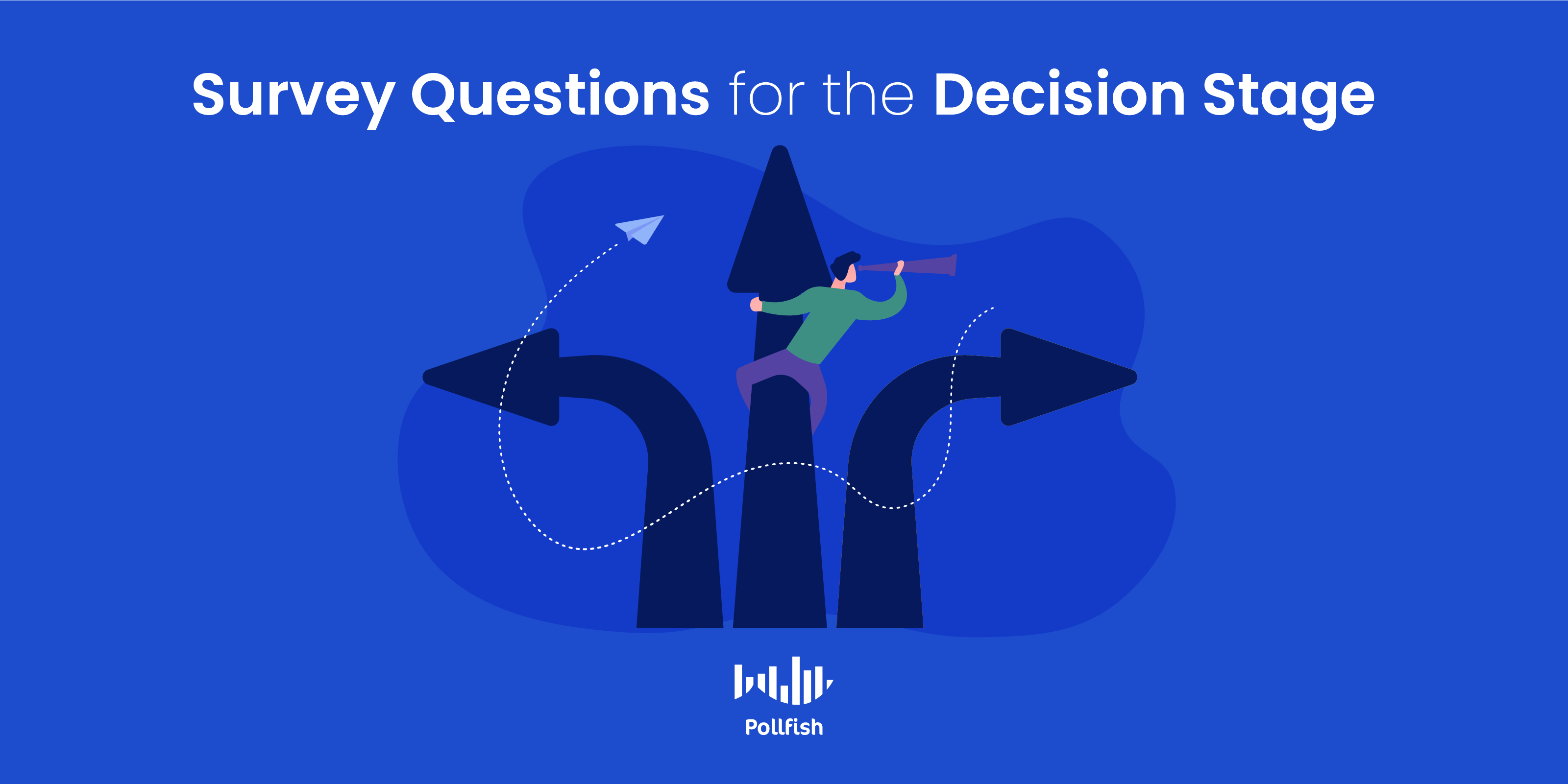
- When thinking about other companies that provide product X, which brands come to mind?
- Answer type: Multiple-choice, with an open-ended field option
- If all of the brands that can fix the problem had different prices, which would you purchase from?
- Answer type: Multiple-choice, Matrix question with options that mention price, capabilities and quality
- Which company are you most likely to buy from to fix your problem?
- Answer type: Multiple-choice, multiple-selection,
- Have you considered switching brands for this problem?
- Answer type: Yes or no, followed by a follow-up question on what would make them switch brands or try yours.
- Does this ad make you want to buy from us? [Use a multimedia file, such as an image or video that features your brand’s strongest capabilities to fix the customers’ problem.]
- Answer type: Yes or no, with an open-ended field option
- Answer type:
Optimizing the Customer Journey Survey
Being attuned to the customer journey is important, as it lets market researchers and businesses understand what their customers go through before finally making a purchase, or cutting their journey short before converting.
The customer journey survey assures that businesses can both map out their customer journey and understand their customers’ decisions throughout it. This kind of approach is strategic to better understanding customer expectations and is therefore crucial for optimizing the customer experience.
Aside from setting up this survey, market researchers need to use a strong online survey platform to carry out this survey campaign.
The most potent online survey platform makes it easy to make your own survey in three easy steps, offers advanced skip logic to route certain respondents to the correct follow-up questions, uses random device engagement (RDE) sampling to engage respondents in their natural digital environments, as opposed to pre-recruiting them, implements artificial intelligence and machine learning to disqualify poor-quality survey data and much more.
Businesses who use an online survey tool with these capabilities and more are well-equipped to create customer journey surveys, deploy them, map out their customer journeys and become well-adapted to their customers.
Optimizing the Customer Buying Journey with Surveys
Optimizing the Customer Buying Journey with Surveys
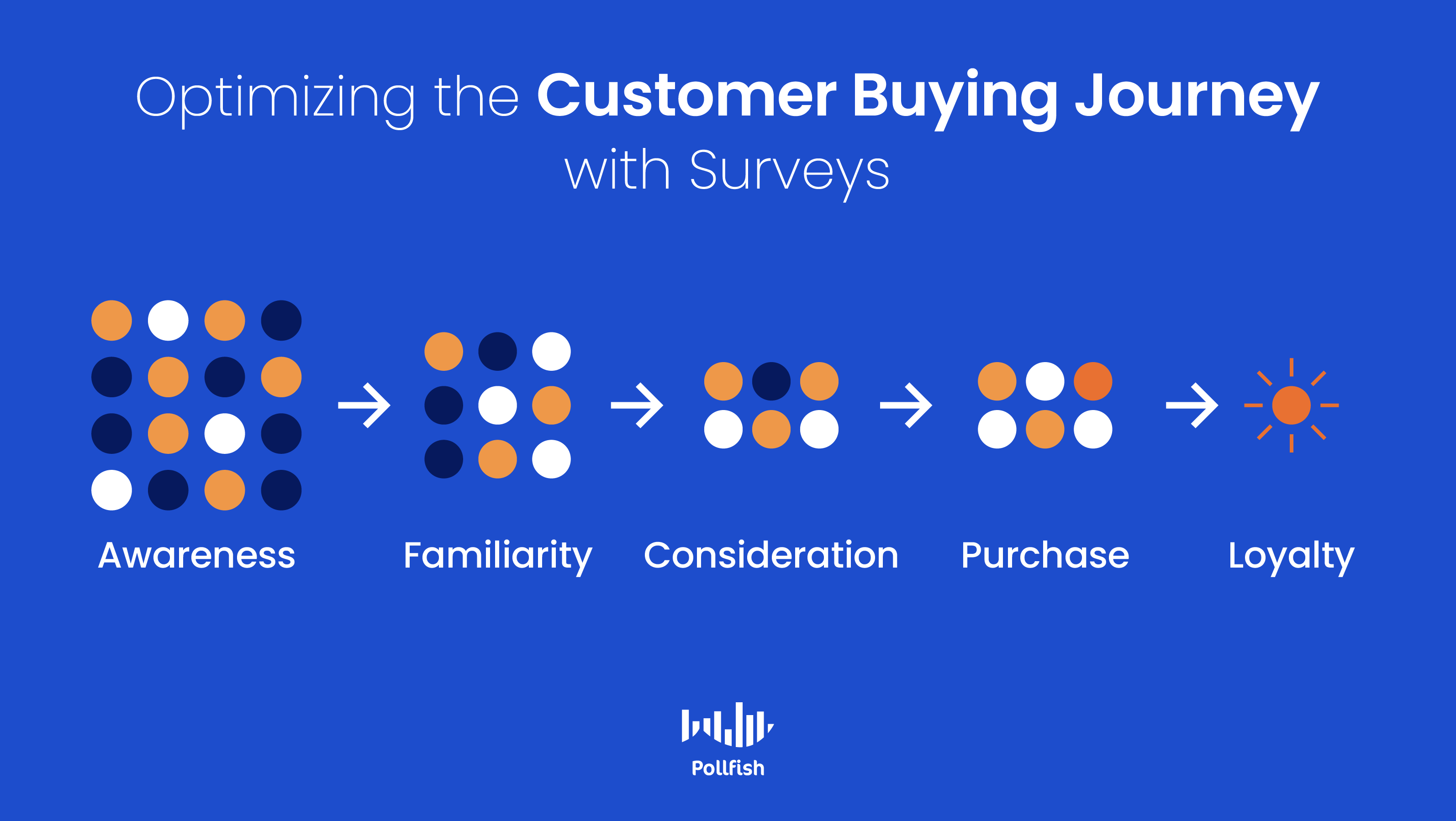
To properly execute their strategy, businesses need to study their customer buying journey, adapt to it and optimize it so that customers experience a quicker path to purchase.
Marketing and market research departments, therefore, need to actively engage in their sales cycle to optimize their customer journeys.
Given that shoppers today have a wealth of information within reach, it affects their customer buying behavior and in turn, their buying journeys. 67% of the customer buying journey takes place digitally. Businesses can take advantage of this digitized shopping, by nurturing and studying their target market online.
Surveying customers as they meander through their buying journey is a solid technique to better understand them, their thought process and their buying journey.
This article delves into the customer buying journey, explaining its importance, its three main stages, how survey research can help optimize this journey and more.
Understanding the Customer Buying Journey
This concept refers to the customer’s path to making a purchase. The customer buying journey is a process in which customers become aware of, examine evaluate and make the decision to purchase a new product or service.
This occurs, as most customers do not suddenly decide to purchase something on a whim; rather they consciously wade through three main stages that make up the typical customer buying journey. These stages are the awareness, consideration and decision stages.
The customer buying journey is essentially an active kind of research process that customers participate in before they make a purchase. During this journey, they encounter both customer and brand experiences, both of which impact the course of their journey, along with the customers’ final decision.
In a nutshell, this process involves everything that a customer would need to do before deciding whether or not to purchase from a business.
The Importance of the Customer Buying Journey
The buying journey holds an abundance of importance for businesses and customers. Businesses can take advantage of it by providing value and answers to customers at each stage. By doing so, they can successfully nurture customers to decide to buy from them.
By mapping out a customer journey and studying it, businesses can avoid making mistakes, such as those that come from traditional approaches, including waiting for customers to be ready or using a hard sales pitch.
Businesses can instead take the approach of giving customers all that they need based on the stage in their journey and steering them towards the business. Businesses can also use the buying journey stages to build trust with customers, rather than forcefully egging them on to buy.
This is important, as trust has a massive influence on customers. Nurturing potential customers according to their position in the buying journey gives brands a high potential to build trust, thereby later converting their prospects into customers.
Additionally, the customer buying journey is important because it offers a strategic approach to better understanding customer needs and expectations. When market researchers map out and study this process, they are far better equipped to provide their customers with a good customer experience (CX). CX alone is largely important, as 86% of customers will pay more for a better customer experience.
However since customer expectations are constantly shifting for all businesses, regardless of their size, all businesses must pay attention to their customer behavior in their buying journeys. Becoming attuned to this journey enables businesses to understand their target market better, giving them the advantage to optimize their customer buying journeys and win over leads.
Mapping the customer journey also includes the benefit of allowing businesses to improve and accelerate their customer onboarding process. This will allow new customers to get acquainted with and begin using a new product more efficiently and with ease. A quickened customer onboarding process delivers value to customers much sooner, granting them more fulfilling product satisfaction.
Moreover, studying the buying journey enables brands to understand the key differences in their customer personas as they move through the stages of the buying journey. Not every persona can feasibly convert from a prospect to a paying customer through the same efforts. As such, businesses should be aware of their customer journeys within all of their customer segments.
All in all, the buying journey is an increasingly important framework that all businesses should use to outline their marketing and strategic planning process, as it can improve sales.
The Three Stages of the Customer Buying Journey
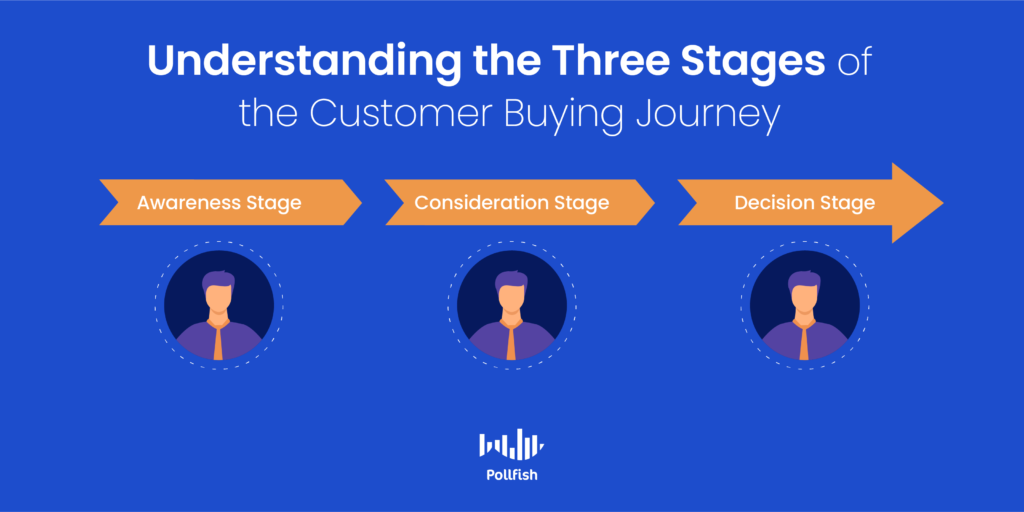
As aforementioned, this journey is composed of three main stages: awareness, consideration and decision stages.
When planning out marketing strategies, businesses need to lay out this process for each of their customer personas. That way, the content and other marketing collateral they produce will be useful for each persona at every stage.
The following explains the three stages of the buying journey:
The Awareness Stage
In this stage, customers become aware that they have a problem. As a means of addressing the problem, customers will search the web for resources. These include consuming content on the cause of the problem.
While reading through this kind of content, which can include blogs, videos, infographics and articles, the customers identify the source or core of their problem. As such, at the end of this stage, customers often leave with a new sense of their true problem, meaning that it may be slightly or entirely different than their original problem.
To adapt to this stage, brands ought to focus on content that addresses customer pain points, which can help customers extract more issues related to their problem (that your business can solve).
Brands should implement industry-focused content and social media to grant an authoritative point of view. Advertising and PR that make mention of the customers’ problem is also necessary for this stage.
The Consideration Stage
In the middle stage, customers define their problem after narrowing it down in the previous stage and consider their options to solve it. In this stage, customers become solution aware, as they evaluate specific products and services and consider different buying criteria.
To adapt to this stage, businesses should show prospects what it is like to use their products and services specifically, focusing on how they provide solutions.
As such, they should use the following marketing collateral and content to nurture prospects in this stage: webinars, case studies, demos, vendor comparisons and trials, along with offers to entice customers to a brand, such as free samples and trials.
The Decision Stage
In the final stage, customers understand the solution they need and just have to decide on which provider, product, or service to use to carry out their solution. It involves customers deciding on their purchase; as such, it often includes speaking with a salesperson, especially in B2B industries.
In this stage, customers are provider-aware; for brands to adapt to this stage, they need to understand the objections that their prospects may have and handle them immediately.
They also need to provide their customers with a unique selling proposition. This will show customers how a business offers value to them and what sets the brand apart from its competitors.
By this stage, the potential customers will have done all the research to be well informed on the services that will fit their needs best, along with the companies they believe are most suitable. As such, businesses must prove their superiority through customer reviews, testimonials and case studies.
Additionally, any content that posits a business as the better choice over a competitor is necessary to persuade potential customers to buy.
How Surveys Optimize the Customer Buying Journey

Optimizing this journey involves understanding your customers at a granular level, especially as it concerns their purchasing behaviors, as every customer persona, let alone an individual customer, is different.
No matter how well a business understands its customers — whether it involves their lifestyle, demographics, opinions, wants, or needs — these aspects are subject to change. With new technologies, innovations to products and changes to services, customers acclimate and change alongside them.
Businesses must follow suit by keeping up with not only the changes within their industry but also their customers’ reactions and subsequent behavior in light of those changes. Surveys are the most equipped tools for garnering granular and up-to-date customer insights.
That’s because, with surveys, businesses can obtain customer feedback within all the stages of the customer buying journey. Moreover, surveys equip businesses with a deep understanding of their customer segments, allowing them to perform market segmentation and identify customer personas.
With these insights in tow, businesses can map out the customer buying journey for each of their customer segments and personas, creating a more personalized experience, which is key to a good CX.
Businesses can also survey their customers on their experience and expectations in each stage of their customer buying journey. This will ensure that they are properly marketing to them, answering key questions and setting themselves apart in a competitive setting.
Surveys also provide insight into customers’ specific problems, showing businesses how they can innovate and perfect their existing products, services and experiences. As such, surveys are the lynchpin to understanding a target market, allowing businesses to optimize each stage of their buying journey.
Being Attuned to Customers in an Omnichannel Setting
Customers seek highly personalized experiences as they wade through their customer buying journey. They reach a particular brand through various channels in their buying journey, which is known to brands as using the omnichannel approach.
To deliver a viable omnichannel approach, businesses must map out their customer buying journeys for various customer segments and personas. To do so aptly, they need to use surveys, as explained above. However, they must decide on a robust online survey platform to obtain valuable results.
To do so, they ought to use an online survey platform that offers a user-friendly interface for creating and deploying surveys to a massive network across websites, mobile sites and apps.
A strong survey tool offers advanced skip logic to route respondents to relevant follow-up questions, implements quality data checks via artificial intelligence and machine learning, offers a wide range of filtering data options, engages respondents in their natural digital environments via random device engagement (RDE) sampling and much more.
With such an online survey platform, businesses can easily glean insights into their customer preferences and buying habits, allowing them to accurately map out their customer buying journey and optimize it to increase their revenue.


